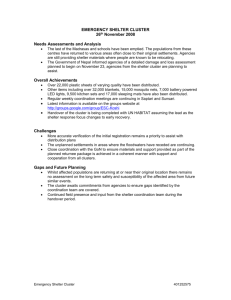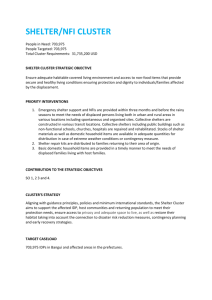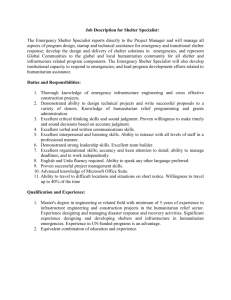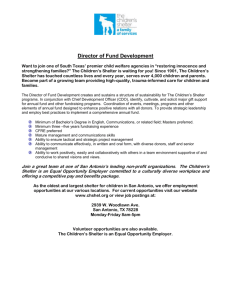Emergency Shelter Cluster Strategic Framework Cyclone Nargis 19
advertisement
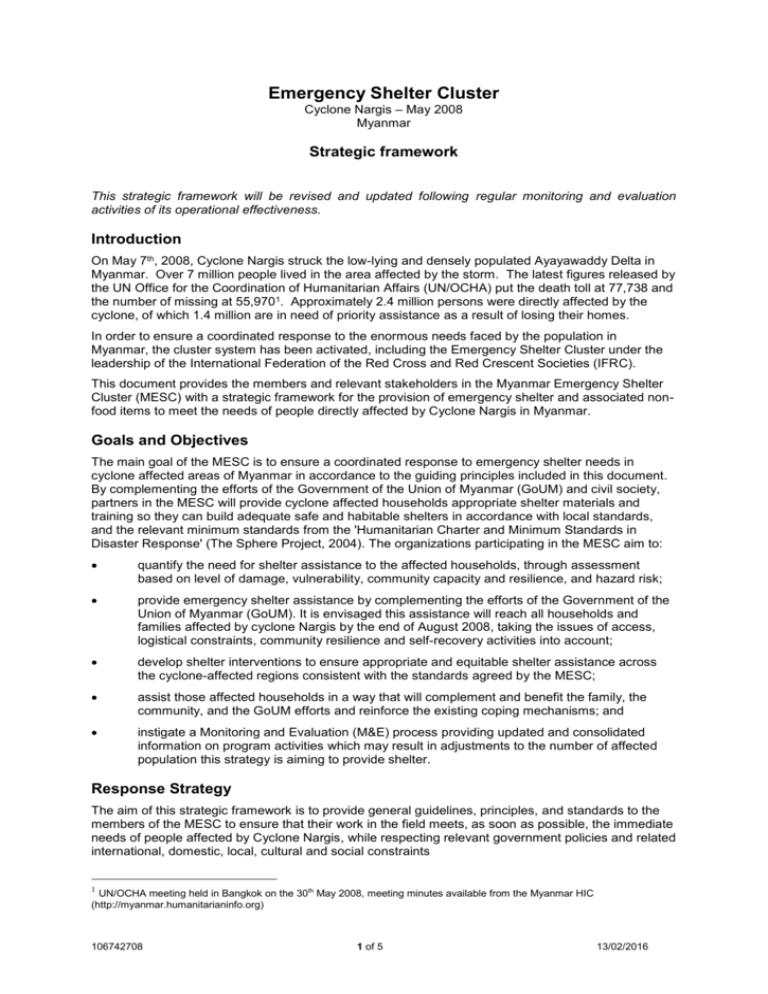
Emergency Shelter Cluster Cyclone Nargis – May 2008 Myanmar Strategic framework This strategic framework will be revised and updated following regular monitoring and evaluation activities of its operational effectiveness. Introduction On May 7th, 2008, Cyclone Nargis struck the low-lying and densely populated Ayayawaddy Delta in Myanmar. Over 7 million people lived in the area affected by the storm. The latest figures released by the UN Office for the Coordination of Humanitarian Affairs (UN/OCHA) put the death toll at 77,738 and the number of missing at 55,9701. Approximately 2.4 million persons were directly affected by the cyclone, of which 1.4 million are in need of priority assistance as a result of losing their homes. In order to ensure a coordinated response to the enormous needs faced by the population in Myanmar, the cluster system has been activated, including the Emergency Shelter Cluster under the leadership of the International Federation of the Red Cross and Red Crescent Societies (IFRC). This document provides the members and relevant stakeholders in the Myanmar Emergency Shelter Cluster (MESC) with a strategic framework for the provision of emergency shelter and associated nonfood items to meet the needs of people directly affected by Cyclone Nargis in Myanmar. Goals and Objectives The main goal of the MESC is to ensure a coordinated response to emergency shelter needs in cyclone affected areas of Myanmar in accordance to the guiding principles included in this document. By complementing the efforts of the Government of the Union of Myanmar (GoUM) and civil society, partners in the MESC will provide cyclone affected households appropriate shelter materials and training so they can build adequate safe and habitable shelters in accordance with local standards, and the relevant minimum standards from the 'Humanitarian Charter and Minimum Standards in Disaster Response' (The Sphere Project, 2004). The organizations participating in the MESC aim to: quantify the need for shelter assistance to the affected households, through assessment based on level of damage, vulnerability, community capacity and resilience, and hazard risk; provide emergency shelter assistance by complementing the efforts of the Government of the Union of Myanmar (GoUM). It is envisaged this assistance will reach all households and families affected by cyclone Nargis by the end of August 2008, taking the issues of access, logistical constraints, community resilience and self-recovery activities into account; develop shelter interventions to ensure appropriate and equitable shelter assistance across the cyclone-affected regions consistent with the standards agreed by the MESC; assist those affected households in a way that will complement and benefit the family, the community, and the GoUM efforts and reinforce the existing coping mechanisms; and instigate a Monitoring and Evaluation (M&E) process providing updated and consolidated information on program activities which may result in adjustments to the number of affected population this strategy is aiming to provide shelter. Response Strategy The aim of this strategic framework is to provide general guidelines, principles, and standards to the members of the MESC to ensure that their work in the field meets, as soon as possible, the immediate needs of people affected by Cyclone Nargis, while respecting relevant government policies and related international, domestic, local, cultural and social constraints 1 UN/OCHA meeting held in Bangkok on the 30th May 2008, meeting minutes available from the Myanmar HIC (http://myanmar.humanitarianinfo.org) 106742708 1 of 5 13/02/2016 Given the magnitude of the needs and the constraints faced by humanitarian organizations in Myanmar, the strategy of the MESC focuses on the provision of emergency shelter as quickly as possible to provide the 1.4 million people who have lost their homes with emergency shelter. Emergency shelter will be provided with an expectation that the materials will ultimately contribute to the construction of transitional or permanent shelter solutions in the future. Operationally, MESC members will strive to: a. use community-based approaches to encourage the participation of affected people in the design and implementation of shelter solutions; b. relocate individuals and families only if it is appropriate, and that the previously occupied area has been rendered unsafe due to the cyclone; c. minimise displacement by encouraging on-site, owner-driven self reconstruction; d. provide shelter solutions that are culturally appropriate and respectful of the environment and natural resources; e. define a set monetary value for different types of shelter and NFI 2 assistance packages; f. ensure equity across all vulnerable groups; the most vulnerable groups 3 may require disproportionate humanitarian and technical assistance; g. retain the focus and goals of the shelter program and provide emergency shelter until those in need and without adequate shelter are provided for; h. avoid duplication and overlap in assistance provided. All actors will update information through the MESC and using the MESC website to include who, what, where and assist in the standardisation of approach; i. cover the total needs of the beneficiary community and avoid partial coverage of needs; j. ensure that the provision of materials (wood, bamboo etc.) are procured through certified legal and sustainable forested areas, or from materials no longer productive due to damage from the cyclone, while at the same time guided by information about availability and price developments in the local market; and k. support the recovery of the local economy by buying locally at reasonable prices where possible. MESC agencies are committed to maximise the use of salvaged and local/indigenous materials from sustainable and legally certified sources, wherever possible. MESC members are also committed to assist in skills development of the local population to assist in the emergency recovery and reconstruction process. The MESC aims to provide its members with a clear distinction between emergency shelter, transitional shelters, and reconstruction through the provision of example designs, costs, standards and references. The designs, standards and references are to provide various possible solutions to construct shelters having greater resistance to cyclone conditions. While the MESC will work to ensure gaps in the provision of assistance are filled, the Emergency Shelter Cluster will not be responsible for any physical or urban planning, land tenure discussions or the implementation of the transitional or permanent shelter phases of the response. Land issues will be addressed by landowners, local authorities and the early recovery phase of the response. 2 3 NFI = Non-Food Items related to shelter and sustainable settlement Widows, child and female-headed households, the elderly, and the physically and mentally disadvantaged 106742708 2 of 5 13/02/2016 Operational Priorities 1. Provide immediately materials that are adaptable for the emergency and transitional shelter solutions, such as corrugated iron sheeting, plastic sheeting, non-plastic tarpaulin, timber, bamboo poles, etc, together with relevant fixing materials complemented by appropriate shelter-related non-food items4. 2. Establish an assessment and monitoring system that will support adequate and timely transition to the recovery phase through a clear comprehension of the changing needs of the affected population. 3. To provide toolkits to all affected communities within three months to increase their capacity for self recovery. 4. To use as a standard in the emergency phase the standard of the three kits that have been developed with the aim that they will be distributed in the following ration: Tarp kit, 1 kit per Household; Community tool kit, 1 kit per 5 households; and the Relief kit, 1 kit per Household (see annex). 5. To start the early recovery programme in parallel with the emergency shelter programme, through in depth assessments and the development of appropriate temporary housing in close coordination with the Early Recovery Cluster. 6. Cash incentives are to be investigated as to their appropriateness in this response and reported back to the cluster members for action. 7. Agencies should where possible target first the most vulnerable5 people that were directly affected by the cyclone. 8. Agencies should endeavour to support as many affected families as possible in the shortest possible time, with total coverage of their needs. Management and Coordination Effective coordination is essential to meet the needs in Myanmar. In order to achieve the required coordination, MESC coordination teams have been established in Myanmar and Thailand. The Yangon-based MESC coordination team will lead the coordination process, while the Bangkok-based team will provide technical, information management and coordination support. The coordination teams will: 1. facilitate the establishment of common standards in the provision of shelter assistance to ensure equitable access to assistance across cyclone-affected areas; 2. provide technical advise to shelter clusters at Township level, to be led by a committed (focal point?) organization for that township 3. track shelter-related materials being transported to and within Myanmar; 4. conduct a gap analysis of outstanding needs on a regular basis and prioritize allocation of resources with the partners; 5. support the GoUM in the coordination at the national and local level by disseminating their policies, regulations and codes to the partners; 6. maintain and regularly update information resources on the emergency response to help identify when the emergency response should evolve into a transitional/permanent shelter response; and 7. keep local Government informed on activities throughout the emergency shelter, recovery and reconstruction process. 4 5 prioritized list to be defined by the Cluster Technical working group; Widows, child and female-headed households, the elderly, and the physically and mentally disadvantaged; 106742708 3 of 5 13/02/2016 Technical Working Groups (TWGs), comprising selected technical advisers from within the MESC will be formed as required to define problems, advise, and provide a solution to technical issues that may be brought forward by members of the cluster. TWGs will be formed and disbanded as needed, and will be determined by requests and needs from Yangon and cluster members. TWGs will: provide low-cost shelter designs to fit most situations found in the field; and identify and prioritize non-food materials and tools required by affected families and communities. The documents developed by the TWGs will be available for viewing and download at the following link: http://myanmar.humanitarianinfo.org/Shelter/Technical%20Guidance/Forms/AllItems.aspx The creation of an in-country cluster supported by township based clusters requires unique reporting procedures to be adhered to in an attempt to reduce duplication of information and efficiency of information sharing. The lead for these clusters will be organized according the geographical commitment of identified organizations (see matrix attached). These organisations will participate in the Strategic Advisory Group (SAG) where possible. Members of other crosscutting clusters, such as the Early Recovery Cluster and the Agricultural Cluster, will be invited by the SAG to facilitate timely inclusive and appropriate transition to early recovery Guidance and Standards Provision of emergency and transitional shelter assistance will strive to comply with the guidance and standards outlined in the following documents: Policies, regulations, and codes of the GoUM related to housing and sheltering; 'Humanitarian Charter and Minimum Standards in Disaster Response' (The Sphere Project, 2004). With specific reference to Chapter 4. Available for download at: www.sphereproject.org; ‘The Code of Conduct for the International Red Cross and Red Crescent Movement and NGOs in Disaster Relief’. Available for viewing at: http://www.ifrc.org/publicat/conduct/index.asp?navid=09_08; ‘Transitional Settlement: Displaced Populations’ (Corsellis and Vitale, 2005). With specific reference to Chapter 7. Available for download at: www.shelterproject.org; ‘Guide to the use and logistics of plastic sheeting in humanitarian relief’ (IFRC and Oxfam, 2007). Available for download at: www.plastic-sheeting.org; ‘IASC Gender Handbook in Humanitarian Action’ (IASC, 2006). With specific reference to pages 97 to 104. Available for download at: http://ochaonline.un.org/HumanitarianIssues/GenderEquality/KeyDocuments/IASCGenderHan dbook/tabid/1384/Default.aspx; and ‘Transitional settlement and reconstruction after natural disasters’ (United Nations, 2008). Available for download at: http://ochaonline.un.org and www.sheltercentre.org 106742708 4 of 5 13/02/2016 Guiding principles Members of the MESC agree to abide by the following guiding principles: 1. home is more than a dwelling; it is often the place of work. Investment in shelter is as well an investment in restoration of livelihood, health, and social protection of women and families; 2. any assistance should be based on independent assessment of level of damage, vulnerability, community capacity, types of households affected, and hazard risks; 3. the provision of Emergency Shelter materials should create an environment to jump start the recovery process towards more sustainable, durable, and safer shelter solutions; 4. all shelter assistance should contribute to re-building better, ie cyclone-resistant shelter, through public outreach programmes and the delivery of pertinent information and instructions; 5. in support of GoUM, the humanitarian community seeks to address the need for shelter of cyclone-affected people through a self-help support strategy. This approach will maximise reuse of salvaged materials, reduce the provision of additional humanitarian inputs, and increase the recovery capacity of the households with technical knowledge on practical and affordable cyclone-resistant techniques; 6. shelter needs of different households are different. A one-design fitting all solutions may not be appropriate; 7. to avoid inequity in assistance provided, use transparent criteria and standardized approach focussing on the quality of the provision and application of appropriate cyclone-resistant building techniques; 8. humanitarian assistance, however well-intended, must not undermine the social, cultural, economic, or environmental fabric of a community and their neighbours; 9. organizations should coordinate with other actors, including GoUM and local authorities, to ensure that Disaster Risk Reduction (DRR) and mitigation measures are integrated into emergency response plans from the outset; 10. the somewhat arbitrary distinction between what comprises “emergency shelter” and more durable housing and settlement solutions in a minimum displacement situation necessitates close cooperation with the Early Recovery Cluster from the outset; 11. the MESC will not be engaging in physical planning, urban zoning, or land tenure issues as part of this response; 12. a micro-credit based approach may not be appropriate unless households have a secured and well-established livelihood; and 13. an ongoing Monitoring and Evaluation (M&E) process will be implemented during the operations. 106742708 5 of 5 13/02/2016


